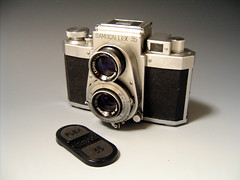Samocaflex 35
The Samocaflex 35 (サモカフレックス35) is a Japanese 35mm TLR made by Sanei Sangyō, later Samoca Camera from 1954 to 1957, and distributed by Hattori Tokei-ten.
Contents
Description
The Samocaflex 35 is shaped as a conventional 35mm camera with a mirror box and viewing lens grafted above the taking lens. The film runs horizontally in a body made of black plastic.[1] The advance knob is at the right end of the top plate, as seen by the photographer. It has an arrow indicating the turning direction and its base is surrounded by an exposure counter. Next to it are the rewind unlock lever and the shutter release. The milled cup surrounding the release button is removable to attach a cable release or a self-timer, and is sometimes missing on the examples found today. The other end of the top plate has an extractible rewind knob, again with an arrow, and an additional direct vision finder. The latter was mainly added to allow easier framing when taking vertical pictures, for which the waist-level finder is very inconvenient.[2]
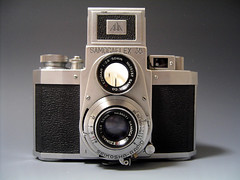  
|
 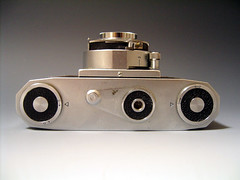 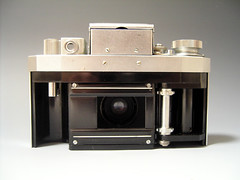
|
| Samocaflex 35 no.55562, D.Ezumar 50mm f/2.8 taking lens no.56071 and viewing lens no.55157, Seikosha-Rapid shutter. Pictures copyright Nakagi Tsuguhide. (Image rights) |
  
|
| Magnifying lens and shutter cocking mechanism. From Shashin Kōgyō September 1955. (Image rights) |
The viewing screen has a condenser for a brighter image.[3] The viewing hood has a magnifying lens hinged to the back and the AAA logo of Sanei Sangyō at the front. The model name is engraved to the front of the mirror box, above the viewing lens. The body serial number is engraved above the direct vision finder.
The back is removable together with the bottom plate for film loading, and it is locked in place by two knobs at the bottom. The bottom plate also has a tripod thread and a pivoting arm allowing the camera to stand upright on a table.
The taking and viewing lenses are mounted together on a focusing helical, driven by a tab at the bottom left. The minimum focusing distance is 3ft.[4] All the models have B, 1–500 speeds and a PC synch post. The shutter cocking lever is coupled to the film advance via an external linkage at the bottom, and the body release linkage is externally visible too. (At the time, some versions of the Compur shutter were already cocked by a rotating shaft on the rear, but this feature was not available on equivalent Japanese shutters, hence the cam and lever mechanism.)[5]
The dimensions are 140×92×64mm, and the weight is 780g.[6]
The original Samocaflex 35
Features
 
|
| Seikosha-Rapid shutter, D.Ezumar lenses. Pictures copyright Nakagi Tsuguhide. (Image rights) |
The original Samocaflex 35 has a Seikosha-Rapid shutter. Most cameras have a pair of seemingly identical D.Ezumar lenses, engraved SAMOCA CO. D.EZUMAR with a red D., and having four elements in three groups.[7] (The "D" in D.Ezumar was perhaps inspired by the D.Zuiko by Olympus, where the fourth letter of the alphabet was used to indicate the presence of four elements.) It seems that the preseries examples have C.Samoca lenses instead, engraved SAN–EI SANGYO C.SAMOCA with a red C. (see below). It is not known if these differ by the name only, or have a lesser optical formula.
 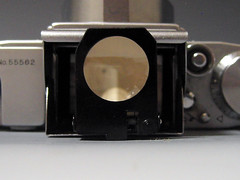
|
| Left: viewing screen with split-image device. Right: magnifying lens in the unfolded position. Pictures copyright Nakagi Tsuguhide. (Image rights) |
It is sometimes said that the original version has no split-image device in the focusing screen but a mere cross.[8] This might be true of some cameras, but at least two examples of the original model have been observed with the split-image device.[9]
Documents

|
| Announcement of the Samocaflex 35 in Shashin Kōgyō August 1955. (Image rights) |
The Samocaflex 35 was already announced in the August-September 1954 issue of Ars Camera, and was first advertised in January 1955.[10] In the February 1955 advertisement in Asahi Camera,[11] the company name is Sanei Sangyō and the distributor is Hattori Tokei-ten. The lenses are called C Samoca 50/2.8 and 50/3.5; it is not completely understood if this is a choice of two versions or if the 50/2.8 is the viewing lens and the 50/3.5 the taking lens. The pictured camera has a plain SAMOCAFLEX engraving above the viewing lens and has silver lens bezels. This version has not been observed yet and perhaps corresponds to a prototype.
In the May 1955 advertisement in Asahi Camera,[12] the taking lens is announced as a four-element D.Ezumar 50/2.8, and the viewing lens as a View Ezumar 50/2.8. The picture shows a regular example, with the SAMOCAFLEX 35 engraving above the viewing lens, and black lens bezels. The company name has become Samoca Camera and the distributor is again Hattori Tokei-ten.
The camera is featured in the news column of the August 1955 issue of Shashin Kōgyō.[13] The August and September issues of the same magazine have advertisements for the camera, mentioning both the manufacturer and the distributor.[14] These documents give the price of ¥16,000, and mention D.Ezumar 50/2.8 lenses, and — from September — Proxa No.2 and No.3 close-up lenses at ¥1,600 each (see below). Detailed articles on the Samocaflex also appear in the September and October issues of the magazine, written by Matsuda Shizuo and Kitano Kunio.[15]

|

|

|
| Advertisements in Shashin Kōgyō August and September 1955, and April 1956. (Image rights) | ||
In the advertisement in Shashin Kōgyō April 1956, the camera is called "Samocaflex-35 Automat" (サモカフレックス-35オートマット) and the price is unchanged (¥16,000).[16] The picture shows an older preseries example, with the SAN–EI SANGYO C.SAMOCA lens engravings.
Variations
The camera pictured in a February 1955 advertisement has silver lens bezels and a SAMOCAFLEX engraving instead of SAMOCAFLEX 35; it was certainly a prototype. It seems that the first batch of cameras have a seven-digit serial number beginning in 54 and the older C.Samoca lens name. The prefix "54" probably indicates the year of production, the remaining digits being the production number itself. No surviving example of these has yet been observed, but they appear in some of the documents mentioned above.[17]
Most of the actual examples observed so far have a five or six-digit body number beginning in 55. The prefix "55" probably indicates the release year, the remaining digits being the production number itself. Body numbers 55042 and 55080 are pictured in some original documents.[18] Surviving cameras are known from 55174 to 552641, indicating a production of less than 3,000 units for this main batch.[19] The corresponding lens numbers have five digits in the 55xxx to 59xxx range, perhaps in a single common sequence for the taking and viewing lenses.[20]
 
|
| Screws at the front and rear, only present on the early examples. Pictures copyright Nakagi Tsuguhide. (Image rights) |
On about the first half of the batch, the top plate is retained at the front and rear by four apparent screws, which disappeared on later cameras.[21] At the very end of the batch, example no.552641 has a non standard viewing lens, with no marking and a larger front element, as if it were a dummy.[22]
An isolated camera is known with a six-digit body number beginning with 57, and lens numbers in the 70xxx and 71xxx range, perhaps corresponding to a third batch.[23]
The Samocaflex 35 II
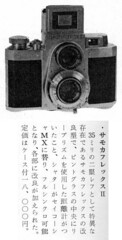
|

|
| Announcement of the Samocaflex 35 II in Shashin Kōgyō June 1956. (Image rights) | Samocaflex 35 II in Shashin Kōgyō Summer 1957. (Image rights) |
The Samocaflex 35 II is similar to the original model but for the Seikosha-MX shutter, with M/X flash synchronization. The name SAMOCAFLEX 35 II is engraved above the viewing lens.
The new model was first advertised in May 1956 and was featured in Japanese magazines dated June 1956,[24] The news column published that month in Shashin Kōgyō mentions the addition of a prism rangefinder on the focusing screen, but this feature was already present on some examples of the original model (see above).[25]
In the July 1956 advertisement in Sankei Camera,[26] the camera is called "Samocaflex-35 Automat" (サモカフレックス-35オートマット), the lenses are D.Ezumar 50/2.8 and the price is ¥18,000, including the leather case. The Proxa No.2 and No.3 close-up attachments are listed at an unchanged price (¥1,600 each).
The last reported advertisement is dated May 1957.[27] The Samocaflex 35 II is listed again in the Summer 1957 special issue of Shashin Kōgyō on Japanese cameras, at an unchanged price.[28] This is the last known mention of the camera.
The Samocaflex 35 II is very uncommon. Examples are known with body no.551848 and 552694, inexplicably mingled within the main batch of the original model; they have lens numbers respectively in the 58xxx and 59xxx ranges.[29] Another example is known with lens numbers in the 70xxx range.[30]
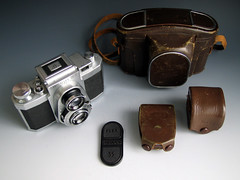 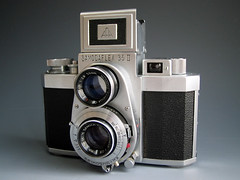 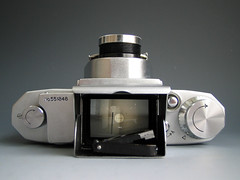
|
       
|
| Samocaflex 35 II no.551848, D.Ezumar 50mm f/2.8 taking lens no.58276 and viewing lens no.58263, Seikosha-MX shutter. Pictures copyright Nakagi Tsuguhide. (Image rights) |
Accessories

|
| Camera with lens cap. Picture copyright Nakagi Tsuguhide. (Image rights) |
The lens cap is made of black plastic, with the name FLEX SAMOCA 35 moulded on it. The ever-ready case is made of brown leather, embossed SAMOCA–35 REFLEX at the front.
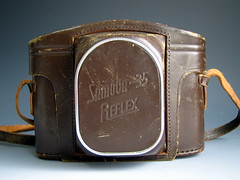 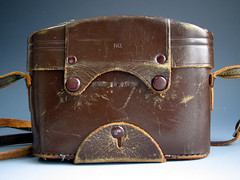
|
| Ever-ready case. Pictures copyright Nakagi Tsuguhide. (Image rights) |
Various advertisements for the Samocaflex 35 and 35 II list two dedicated close-up attachments: the Proxa No.2 for pictures from 15 to 28 inches and the Proxa No.3 for pictures from 10 to 15 inches, at ¥1,600 each.[31] The September and October 1955 issues of Shashin Kōgyō also mention a Proxa No.1 set, apparently ranging from 19 to 36 inches.[32] These attachments include a parallax-correcting element for the viewing lens, and come in a small box inscribed Proxa Par Set "FOR SAMOCA FLEX 35", with the type number and the distance range. A lens hood and a dedicated flash gun are also mentioned in the same magazine.[33]
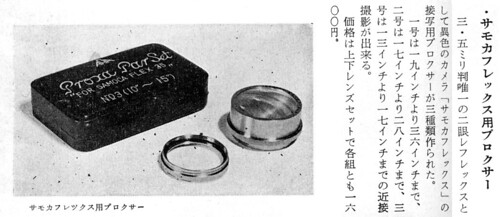
|

|
| Announcement of the Proxa Par Set in Shashin Kōgyō October 1955. | Proxa Par set on the camera. From Shashin Kōgyō September 1955. (Image rights) |
At the time of the Samocaflex, the company was also selling a Samoca exposure meter in a small brown leather case.
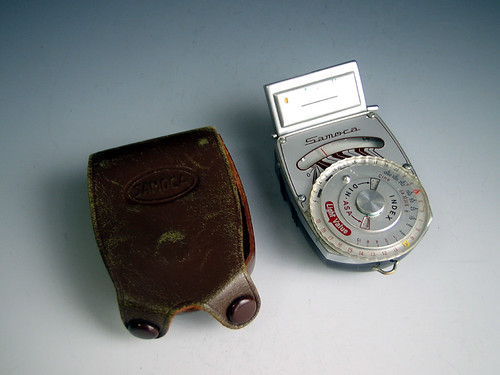
|
| Samoca exposure meter. Picture copyright Nakagi Tsuguhide. (Image rights) |
Notes
- ↑ Made of "high-grade plastic" (高級プラスチック): Matsuda, p.174 of Shashin Kōgyō September 1955. Same information in Awano, p.148 of Kurashikku Kamera Senka no.35.
- ↑ Matsuda, p.174 of Shashin Kōgyō September 1955.
- ↑ Condenser: Matsuda, p.174 of Shashin Kōgyō September 1955, Kitano, p.238 of Shashin Kōgyō October 1955, and advertisements reproduced in this page and in Kokusan kamera no rekishi, p.139.
- ↑ Matsuda, p.174 of Shashin Kōgyō September 1955, and Kitano, p.238 of Shashin Kōgyō October 1955. Other documents say 1m instead, such as the news column in Shashin Kōgyō August 1955, p.84, or the advertisement on p.78 of the same. It seems that all the examples are labeled in feet.
- ↑ Matsuda, p.173 of Shashin Kōgyō September 1955.
- ↑ Shashin Kōgyō September 1955, p.168.
- ↑ Four elements in three groups: Matsuda, p.173 of Shashin Kōgyō September 1955. Mention of four elements is made in other articles and advertisements as well.
- ↑ Awano, p.148 of Kurashikku Kamera Senka no.35. This is perhaps based on the announcement of the Samocaflex 35 II in Shashin Kōgyō June 1956, p.429, where the new model is said to have a prism rangefinder on the focusing screen.
- ↑ Examples pictured in this page and observed in an online auction.
- ↑ Kokusan kamera no rekishi, p.352.
- ↑ Advertisement reproduced in Kokusan kamera no rekishi, p.139.
- ↑ Advertisement reproduced in Kokusan kamera no rekishi, p.139.
- ↑ News column in Shashin Kōgyō August 1955, p.84.
- ↑ Advertisements in Shashin Kōgyō August 1955, p.78, and September 1955, p.154.
- ↑ Shashin Kōgyō September 1955, pp.168 and 172–4, and October 1955, pp.236–8.
- ↑ Advertisements in Shashin Kōgyō April 1956, p.237.
- ↑ Example no.540011x pictured in Matsuda, p.172 of Shashin Kōgyō September 1955, example with C.Samoca viewing lens pictured on p.174 of the same, and example with C.Samoca lenses pictured in the advertisement in Shashin Kōgyō April 1956, p.237. The association of the 54xxxxx serial number and C.Samoca lenses is probable, but does not appear clearly on these pictures.
- ↑ Example no.55042 pictured in Kitano, Shashin Kōgyō October 1955. Example no.55080, with taking lens no.55362 and viewing lens no.55251, was used for a set of pictures certainly taken by the manufacturer. The body number is visible in Matsuda, p.172 of Shashin Kōgyō September 1955 (the third digit is hardly legible), and the camera also appears in the advertisement on p.154 of the same, and in the news column on p.84 of Shashin Kōgyō August 1955.
- ↑ One example has been reported with seven-digit no.5512526, but this is perhaps a mistake. See lot no.417 of Christies sale no.8590 (November 25, 1999).
- ↑ Taking lens numbers are known from 55238 to 58877, and viewing lens numbers from 55157 to 59768.
- ↑ See for example the pair of Samocaflex 35 sold as lot no.143 of Christies sale no.5688 (February 15, 2005).
- ↑ Example sold as lot no.386 of Westlicht Photographica Auction no.1 (November 15, 2002); see link below.
- ↑ Example sold as lot no.68 of the March 25, 2006 auction by Auction Team Breker. It has body no.571157, taking lens no.71646 and viewing lens no.70013.
- ↑ Kokusan kamera no rekishi, p.388.
- ↑ Shashin Kōgyō June 1956, p.429: ピントグラスの中央にリープリズム[sic]を使用した距離計がついた.
- ↑ Advertisement reproduced in Kokusan kamera no rekishi, p.252.
- ↑ Kokusan kamera no rekishi, p.388.
- ↑ Column in Shashin Kōgyō no.63, p.111, reproduced in this page. It is not listed in Kokusan kamera no rekishi, p.356.
- ↑ Body no.551848 pictured in this article and formerly in a page at AEI Collectibles, body no.552694 pictured in this Flickr set by Cassianius.
- ↑ Example offered for sale by a Japanese dealer.
- ↑ Advertisement in Shashin Kōgyō September 1955, p.154; advertisement in Sankei Camera July 1956, reproduced in Kokusan kamera no rekishi, p.252.
- ↑ Column in Shashin Kōgyō October 1955, p.257. The article by Matsuda, p.174 of Shashin Kōgyō September 1955, mentions the following distances: 1.8–3.6ft for No.1, 1.5–2.8ft for No.2, and 1.1–1.5ft for No.3, but these are certainly wrong.
- ↑ Shashin Kōgyō September 1955, p.168.
Bibliography
Original documents
- Kitano Kunio (北野邦雄). "Atarashii kamera: Samokafurekkusu 35" (新しいカメラ・サモカフレックス35, New cameras: Samocaflex 35). In Shashin Kōgyō no.40, October 1955. Pp.236–8.
- Matsuda Shizuo (松田静夫). "Samokafurekkusu 35" (サモカフレックス35, Samocaflex 35). In Shashin Kōgyō no.39, September 1955. Pp.168 and 172–4.
- Shashin Kōgyō no.38, August 1955. Advertisement on p.78 and "Nyūsu furashu" (ニュースフラシュ, News flash), p.84.
- Shashin Kōgyō no.39, September 1955. Advertisement on p.154.
- Shashin Kōgyō no.40, October 1955. "Nyūsu furashu" (ニュースフラシュ, News flash). P.257.
- Shashin Kōgyō no.46, April 1956. Advertisement on p.237.
- Shashin Kōgyō no.49, June 1956. "News flash". P.429.
- Shashin Kōgyō no.63, Summer 1957. "Nihon no kamera zenbō: 35-miri kamera renzu shatā tsuki" (日本のカメラ全貌・35ミリカメラ・レンズシャター付, Compendium of Japanese cameras: 35mm cameras with lens shutter). P.111.
Recent sources
- Asahi Camera (アサヒカメラ) editorial staff. Shōwa 10–40nen kōkoku ni miru kokusan kamera no rekishi (昭和10–40年広告にみる国産カメラの歴史, Japanese camera history as seen in advertisements, 1935–1965). Tokyo: Asahi Shinbunsha, 1994. ISBN 4-02-330312-7. Items 531 and 1306.
- Awano Mikio (粟野幹男). "Nigan-refu sutairu no 35mm-han LS-kamera: Samokafurekkusu 35" (二眼レフスタイルの35mm判LSカメラ・サモカフレックス35, The Samocaflex 35, a 35mm leaf-shuttered camera of TLR style.) Kamera Rebyū: Kurashikku Kamera Senka (カメラレビュー クラシックカメラ専科) / Camera Review: All about Historical Cameras no.35, November 1995. Nihon no kamera 50nen (日本のカメラ50年, special issue on 50 years of Japanese cameras). P.148.
- Kuno Mikio (久野幹雄). "35mm-han nigan-refu no sekai" (35mm判二眼レフの世界, The world of 35mm TLRs.) Kamera Rebyū: Kurashikku Kamera Senka (カメラレビュー クラシックカメラ専科) / Camera Review: All about Historical Cameras no.10, September 1987. No ISBN number. Konishiroku kamera no rekishi (小西六カメラの歴史, special issue on Konishiroku). Pp.128–30.
- McKeown, James M. and Joan C. McKeown's Price Guide to Antique and Classic Cameras, 12th Edition, 2005-2006. USA, Centennial Photo Service, 2004. ISBN 0-931838-40-1 (hardcover). ISBN 0-931838-41-X (softcover). P.869.
- Sugiyama, Kōichi (杉山浩一); Naoi, Hiroaki (直井浩明); Bullock, John R. The Collector's Guide to Japanese Cameras. 国産カメラ図鑑 (Kokusan kamera zukan). Tokyo: Asahi Sonorama, 1985. ISBN 4-257-03187-5. Items 3758–9.
- Watakushi no ni-gan-refu kamera-ten (私の二眼レフカメラ展, Exhibition of twin lens reflex cameras). Tokyo: JCII Camera Museum, 1992. (Exhibition catalogue, no ISBN number.) P.31.
Links
In English:
- History of the 35mm TLR in John Marriage's Photo-history pages
- 35mm TLR at Massimo Bertacchi's Innovative cameras, also reproduced here at Fotografia e Reflex (these pages are based on the above article by John Marriage)
- Samocaflex 35 among 35mm cameras at Cameras Downunder
- Samocaflex 35 II Flickr set by Cassianius
- Past auctions by Auction Team Breker:
- Samocaflex 35: lot no.65 of the April 30, 2005 Photographica and Film auction, also in the highlights of the sale
- Samocaflex 35: lot no.68 of the March 25, 2006 Photographica and Film auction
- Past auctions by Christies:
- Samocaflex 35, lot no.31 of sale no.8021 (June 11, 1998)
- Samocaflex 35, lot no.417 of sale no.8590 (November 25, 1999)
- Samocaflex 35, lot no.222, and other Samocaflex 35, lot no.223 of sale no.8852 (August 24, 2000)
- Samocaflex 35, lot no.33 of sale no.9124 (June 12, 2001)
- Pair of Samocaflex 35, lot no.143 of sale no.5688 (February 15, 2005)
- Samocaflex 35, lot no.386 of Westlicht Photographica Auction no.1 (November 15, 2002)
In Swedish:
- Samocaflex 35, lot no.147 of LP Foto auction no.26 (22 April 2007).
In Japanese:
- Samocaflex 35 at the Classic Camera Beginners' Club
- Samocaflex 35 II at the Holy Oresame Empire blog
In Korean:
